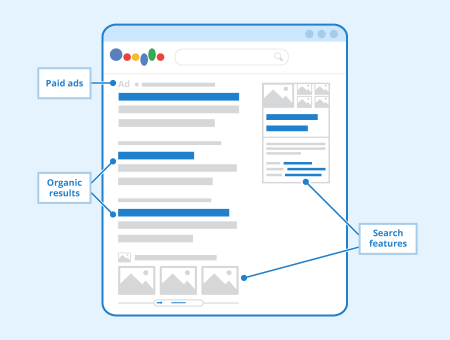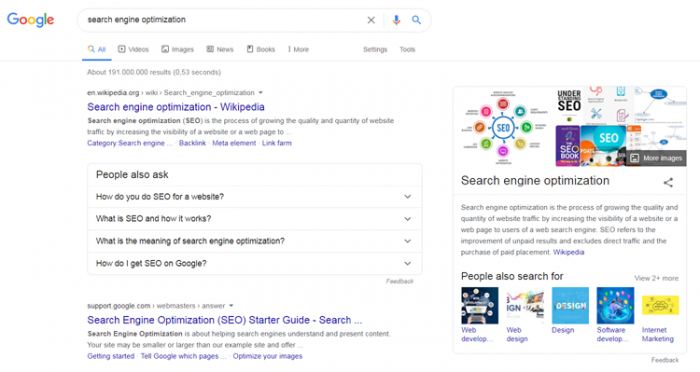What is a SERP?
A SERP (short for “Search Engine Result Page”) is a search result page where search engines like Google display the best results for a user’s search query. The search for suitable content can be based on a single keyword or the combination of several terms. The search engine then lists a variety of carefully selected results in the form of snippets, whose order of display depends on the provider’s algorithm. In addition, the order of results in the SERPs changes regularly.

Search results in the SERPs correlate with the type of query, are sorted by relevance, and usually contain both organic and paid results. For example, Google will usually display appropriately marked ads and Google Shopping Ads with products offered by various competitors above the organic results in a transactional product search. Depending on the search intent, special SERP features which match the user’s query are added, such as featured snippets or answer boxes, knowledge card/panel and videos, images, or articles/news.
This reduces the number of organic results displayed per SERP. Google displays a maximum of ten snippets of that kind.

Screenshot of a SERP for “search engine optimization” with knowledge panel on the right side of google.com.
This means that there are three ways for a website to get into SERPs:
- Paid ads
- Organic results
- SERP features
In online marketing and especially in search engine optimization (SEO), SERPs are of central importance, since high rankings can significantly increase the organic traffic and thus the overall success of a website.
Components of snippets
A SERP snippet usually consists of the following three elements:

Screenshot of a “classic” snippet when searching for “tf*idf tool” from google.com
In SEO, snippets are an important tool for website marketing as they can have a positive effect on [(CTR) Click-Through Rate|click-through rates (CTR)]]. If they encourage users to believe that they have found the right page to answer their query, they are more likely to click on this result. Meta title and meta description should therefore be accurate and convincing and should also contain central keywords. Both can be specified in the meta tags of a web page where they can be found by Google and other search engines. In most [[Content Management System (CMS)|content management systems (CMS), this is possible under a “meta tags” section.
In the end, however, it is the quality of the website content that determines user satisfaction. In the context of snippet optimization, it’s therefore important not to promise more than the actual website content delivers.
It should also be noted that the length of the meta title and meta description should not exceed 580 pixels (approx. 70 characters) and 1,000 pixels (approx. 160 characters). Otherwise, Google will truncate them in the SERPs, which means that essential parts of the information may get lost.
Especially on larger websites, search engines sometimes add sitelinks beneath the page description, which can be helpful for users as they enable them to get a better picture of the website’s content.
Rich snippets also contribute to this. These extensions supplement the SERPs with additional information such as user ratings, event information, personal data, or breadcrumb navigation. Rich Snippets are based on structured data which are added to the web page’s source code. Google can then analyze the data and display this information in its search results. This can have a positive effect on the click-through rate and thus the traffic of the respective website.
Why identical queries can result in different SERPs
Since each search engine has its own algorithm, the SERPs of Google, Bing, Yahoo, etc. often differ considerably when searching for the same keywords. Most search engines don’t share much information about the weighting of individual ranking factors that cause the different results in order to prevent search engine spamming.
But even when using the same search engine, such as Google, search results may differ significantly between users. This is because the world’s leading search engine personalizes its search results based on the user’s search history, current location, and other factors.
Additional Google SERP features
Google’s SERP features improve the user experience by displaying additional results that also fit the search intent of users and help them find what they are looking for. Google also answers more and more user queries directly or independently of traditional search results through newly introduced features like knowledge cards and answer boxes. The idea behind this is that users should not have to visit another web page if they have very specific questions that can be answered directly on the result pages. This is not only helpful for users but also benefits Google itself.
SERP features are partly based on a payment model and partly generated organically. In addition, Google retrieves some answers or the information on which they are based from its Knowledge Graph. This is a semantic online database where Google collects, processes, and correlates search results and information on specific topics, people, and places.
In SEO, SERP features are becoming increasingly relevant as they limit the space that’s available for traditional search results. Web pages that drop on the second results page may receive fewer clicks as most users won’t search further than on page one. Therefore, it’s getting even more important to be listed among the first results and to have an appealing snippet that attracts the clicks of search engine users.
Overview of common SERP features
- Featured snippet
- Knowledge card
- Knowledge panel
- Google Images
- Top stories
- People also ask
- Product Listing Ads
- Tweets boxes
- Videos
Importance of SERPs for SEO
In fact, the majority of users only click on the first three search results while the following results and result pages are mostly ignored. Therefore, the goal of both on-page and off-page SEO is to achieve top search engine rankings which will usually result in increased organic traffic and potentially more sales.
Yet, Google and other search engines are making this task more complicated by regularly releasing new search algorithm updates. As a result, the weighting of individual ranking factors changes regularly and some pages may permanently lose their rankings if site operators don’t adapt their strategies. SEO must take this into account.
Google has only confirmed a few of its approximately 200 ranking factors so far – including content quality, backlinks, page speed, mobile optimization, and HTTPS. Focusing on these factors can be seen as a general SEO recommendation after an algorithm update. Yet, it is controversial whether user signals such as dwell time and click rate are also part of Google’s ranking factors.
As soon as a web page is ranking on the first page of search results, snippet optimization becomes even more important as it may increase CTR. This doesn’t mean that snippet optimization should be ignored beforehand. An informative and appealing snippet can increase the chances of users visiting a web page regardless of its exact position on Google or other search engines.
There are multiple SEO tools available for SERP snippet optimization, such as the Seobility SERP Snippet Generator.
Related links
- https://googleblog.blogspot.com/2012/05/introducing-knowledge-graph-things-not.html
- https://www.seobility.net/en/serp-snippet-generator/
Similar articles
